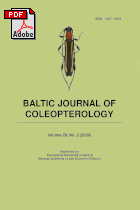Diversity patterns of carabid beetle (Coleoptera, Carabidae) asemblages in the pine forests of Northern Belarus
Main Article Content
Abstrakt
Scotch pine Pinus sylvestris is the dominant tree species in the Northern Belarus, which formed characteristic boreal forest stands of different types on the border between Eurasian coniferous forest zone and European broad-leaved zone. The knowledge of ground beetle diversity in a range of various pine forest types is sparse. We investigated the carabid beetle diversity and species composition structure patterns in 60 sites across the main five pine forest types. We conducted pitfall trapping between April and November of 2018. In total, 3,290 individuals belonging to 62 species were collected. In general, the ground beetle diversity was not high. The Shannon-Wiener index ranged from 1.383 to 2.131. Pine forest type with prevailing Calluna vulgaris in understory vegetation showed the highest Shannon-Wiener index, whereas the lowest values were recorded from Cladoniosum type. NMDS showed differences of species composition of carabid assemblages corresponding pine forest types. The driest Cladoniosum forest type was the most different. The IndVal analysis detected several species which were characteristic for one of the forest types. However, many dominant species preferred two or more pine forest types. A significant difference in carabid species composition was detected, but in pairwise comparisons several types of pine forests revealed no significant differences between each other. In this study ground beetles protected in Belarus such as Carabus coriaceus (NT), and Carabus violaceus (NT) were collected. Among them in pine forests of North Belarus only Carabus violaceus is a relatively common species.
Article Details
Statystyki
Downloads
Download data is not yet available.
Rekomendowane teksty
